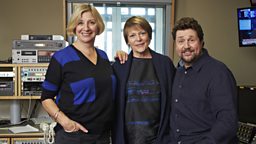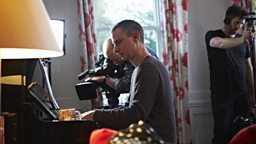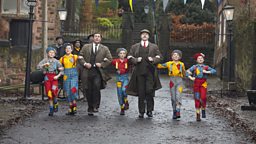Nigel Lilly: "I feel lucky I鈥檓 the first person in the world that gets to hear Victoria鈥檚 songs"

Nigel Lilley is the Musical Director on That Day We Sang. He trained at King’s College, London, and the Royal Academy of Music. His work in theatre includes Talent, Spring Awakening, La Cage aux Folles, the 2008 Royal Variety Performance, Les Misérables, Glitter and Twisted and the C4 series Musicality. Nigel also co-authored a guide to musical theatre auditions with Mary Hammond called Thank You – That’s All We Need for Today.
I remember one morning with Michael Ball up a ladder in Liverpool in the pouring rain at 7am singing his heart out to the bemusement of people on their way to workNigel Lilly
What were your main responsibilities on That Day We Sang?
My initial role is to develop the musical items with Victoria Wood; adding harmonies, dance breaks, expanding the piano accompaniments teaching the material to the cast and finally adding the orchestra. For this TV musical we had three days with session musicians in a studio in London and then a day with the Hallé Orchestra recording in Huddersfield Town Hall. I’ve also worked on both stage versions of That Day We Sang as well as a number of other projects with Victoria Wood.
How different was the collaboration process between you and Victoria compared to the stage play?
We collaborated closely on both versions. I feel lucky that I’m the first person in the world that gets to hear Victoria’s songs. It is a very privileged position to be in. One of the great things about the filming process was the resource at our disposal. When we walked onto the huge soundstage in Manchester for the first time, we were like kids in a sweetshop.
Did you have to adapt any of the music for the TV musical?
We added a song for Enid called ‘Do It’. This is sung while Enid is on the move, travelling on the bus and walking down the street. This seemed easier to achieve cinematically than in the stage versions. We also added some lovely singing Coalmen to ‘Happiness Street’ and put in a few other nips and tucks here and there.
How did you find the filming process compared to working on the stage versions?
Both had different challenges. The main thing with the filming was to have as much live singing on set as possible. We all knew this style of working had happened on the film of Les Miserables but weren’t quite sure how it might work in practice with our musical until we got on the set. We were so proud of having cast two fantastic singers in the leads and we wanted to capitalise on their skills. All the cast did us proud. I remember one morning with Michael Ball up a ladder in Liverpool in the pouring rain at 7am singing his heart out to the bemusement of people on their way to work.
What was it like to work with such talented performers as Imelda Staunton and Michael Ball?
I’d never worked with either Imelda or Michael before but had seen them in lots of things, including their brilliant production of Sweeney Todd. With performers that good, your job really becomes about enabling them to bring their own ideas to the text. The detail they both bring to their work is staggering. Every note, word and breath is examined and within minutes of your first rehearsal you realise why they are both at the very top of their game.
Was it always part of the plan to use the Hallé Orchestra and the Hallé Children’s Choir in the TV musical?
It was always our dream, but we had no idea how it might fit with schedules as both the orchestra and choir are booked up years in advance. All credit to Paul Frift who managed to make a date work for all of us. It felt wonderful to be honouring Hamilton Harty and all of the performers on the original record in that way.



